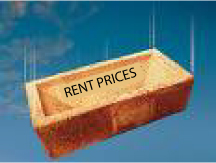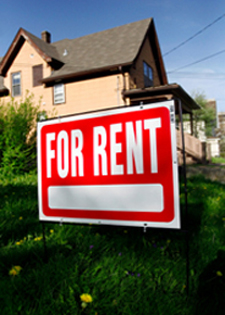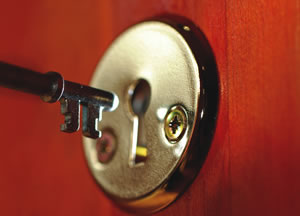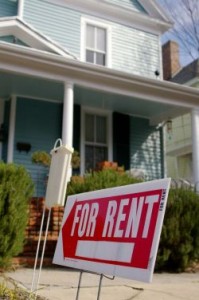Posted by Teresa on January 7, 2010 under Housing Trends, Rental Market | 
Reis, Inc., a real estate research firm just released its 4th Quarter 2009 apartment vacancy report. As expected, it hit 8%—the highest in thirty years. The poor state of the U.S. job market continues to be blamed, as job creation lags behind other positive economic indicators. Young people, who are typically apartment renters, have been hit especially hard in the job market.
A bit more positive is the news that an ever-increasing supply of newly built apartment units is starting to decline—finally catching up with the credit crunch that began in the summer of 2008. 28,000 new apartments came onto the market in the 4th quarter 2009. The total for the year: 120,000, including developments intended for condos that converted to rentals. New apartment supply should fall by half in 2011, and if jobs improve, there could be some rental market recovery by the middle of this year, according to the report.
The U.S. apartment vacancy rate rose .10 percent from the 3rd quarter, and 1.3 percent for the year, ending at 8%. Sunbelt cities like Tucson AZ, and Jacksonville, FL experienced huge vacancy increases in 2009, at 10.5% and 14.4%, respectively. Charlotte, NC and Lexington, KY were also hit hard. Nationwide, vacancies increased in 52 markets, improved in 17, and remained flat in 10.
Not only are vacancies higher than ever, but landlords are experiencing a double-whammy: both asking and effective rents are plummeting. For 2009, asking rents fell 2.3%, also the largest decrease in thirty years; effective rent fell .7% to $964 per square foot.
And while mortgage financing has toughened up, government efforts to enhance the housing market threaten apartment owners, as some renters find it easier to buy a home. In some markets, continued unrest in the housing sector and lower rents will make renting more attractive than buying.
Landlords and rental property owners will likely need to continue offering rent reductions, perks and amenities to entice new tenants—until the job market improves. And when that will happen is anybody’s guess.
 Reis, Inc., a real estate research firm just released its 4th Quarter 2009 apartment vacancy report. As expected, vacancies hit 8%—the highest in thirty years. The poor state of the U.S. job market continues to be blamed, as job creation lags behind other positive economic indicators. Young people, who are typically apartment renters, have been hit especially hard in the job market.
Reis, Inc., a real estate research firm just released its 4th Quarter 2009 apartment vacancy report. As expected, vacancies hit 8%—the highest in thirty years. The poor state of the U.S. job market continues to be blamed, as job creation lags behind other positive economic indicators. Young people, who are typically apartment renters, have been hit especially hard in the job market.
A bit more positive is the news that an ever-increasing supply of newly built apartment units is starting to decline—finally catching up with the credit crunch that began in the summer of 2008. 28,000 new apartments came onto the market in the 4th quarter 2009. The total for the year: 120,000, including developments intended for condos that converted to rentals. New apartment supply should fall by half in 2011, and if jobs improve, there could be some rental market recovery by the middle of this year, according to the report.
The U.S. apartment vacancy rate rose .20 percent from the 3rd quarter, and 1.3 percent for the year, ending at 8%. Sunbelt cities like Tucson AZ, and Jacksonville, FL experienced huge vacancy increases in 2009, at 10.5% and 14.4%, respectively. Charlotte, NC and Lexington, KY were also hit hard. Nationwide, vacancies increased in 52 markets, improved in 17, and remained flat in 10.
Not only are vacancies higher than ever, but landlords are experiencing a double-whammy: both asking and effective rents are plummeting. For 2009, asking rents fell 2.3%, also the largest decrease in thirty years; effective rent fell .7% to $964 per square foot.
And while mortgage financing has toughened up, government efforts to enhance the housing market threaten apartment owners, as some renters find it easier to buy a home. In some markets, continued unrest in the housing sector and lower rents will make renting more attractive than buying.
Landlords and rental property owners will likely need to continue offering rent reductions, perks and amenities to entice new tenants—until the job market improves. And when that will happen is anybody’s guess.
Posted by Teresa on November 5, 2009 under Housing Trends | 
 Where are all the tenants? Some are moving back home with mom and dad. Or returning to school and living with relatives. Others took in roommates to help pay the rent, or are staying with friends temporarily.
Where are all the tenants? Some are moving back home with mom and dad. Or returning to school and living with relatives. Others took in roommates to help pay the rent, or are staying with friends temporarily.
These are some of the reasons tenants are out of the rental market, causing the U.S. apartment vacancy rate to rise to 7.8% in the 3rd quarter. This 23-year high occurred despite landlords nationwide lowering rents. Reis, Inc., a real estate research firm that published the vacancy report, stated that the peak has not yet been reached; they expect the number to climb above 8% in the coming months.
Nervous landlords are looking toward the traditionally slow 4th quarter with little hope for improvement, which is expected sometime in 2010—perhaps as soon as the second quarter.
While vacancies increased, rents have declined for four quarters in a row—which may have kept the vacancy rate from soaring even higher. Landlords have responded quickly to market conditions, including over supply, and lowered rents to keep tenants. Rents are expected to stay soft for at least another year.
Oversupply will continue to be a contributing factor to the vacancy problem. 73,000 apartment units have come on the market in the first three quarters of 2009, and 42% of them remain vacant, according to Reis. The bright spot is that new apartment construction has slowed down to a trickle, so eventually, demand will catch up to supply.
As unemployment hovers near 10% nationwide, and benefits start running out, rent money is disappearing, too. Simply put, folks with no rent money cannot be tenants. Landlords will need to continue aggressively seeking out new tenants to fill vacancies, offer incentives to good tenants to get them to stay, and hold on until the job market improves—when there are more people with money to spend on housing.
Especially in a down economy, we recommend you
screen all tenants as part of your application process. For more landlord resources, including forms and information on
tenant screening, turn to
E-Renter.com. .
Posted by Teresa on November 2, 2009 under Landlord Paperwork and Forms, Landlord Tips | 
 Keeping rental units filled: it’s the number one job of any landlord or property manager. If you have tenants who want to renew their leases, then you are doing it well! Before you decide whether or not to allow a tenant to renew her lease, consider the pros and cons:
Keeping rental units filled: it’s the number one job of any landlord or property manager. If you have tenants who want to renew their leases, then you are doing it well! Before you decide whether or not to allow a tenant to renew her lease, consider the pros and cons:
The pros:
1. There is no “break-in” period as with a new tenant;
2. Both sides know what is expected;
3. Current tenant is already agreeable to your terms;
4. No costly repairs, repainting, and advertising for a new tenant;
5. Landlord knows the tenant’s habits and behavior—so, no surprises;
6. Most important: no loss of rental income!
The cons:
1. You might be “stuck” with a less-than-ideal tenant for another year;
2. There are no guarantees that the tenant will continue to pay rent on time;
3. The tenant might become less diligent about following your rules;
4. Tenant’s job situation and/or income could change in between lease signing.
Even if you are not 100% enthusiastic about 100% of your tenants, those who pay their rent on time and cause little trouble are like gold—and never more so than in the soft rental market we’re in now. It’s usually in the best interests of both parties to renew the lease.
How to Renew Leases
Since rental agreements without renewal clauses expire automatically at the end of lease period, it’s a good idea to approach your tenant at least 60 days before that date. Ask what his intentions are, and offer to write another lease effective when the current one expires.
Research comparable rents in your area—if your rent is within the average range, you may not be able to raise the rent when the tenant renews. Inventories are very high in some areas, and tenants are more in control than in many years. Stay competitive to keep your tenants.
If you must raise the rent, offer an upgrade to your tenant: new carpeting, new paint, upgraded kitchen counters—whatever your rental unit needs. Now could be the time to invest in upgrades in order to keep the unit filled—and you could actually save money if you don’t have the expenses of turning over the rental unit to a new tenant—which could take months to find!
Renewing leases is much easier and cost-effective than finding new tenants—so keep the communication open with your tenants, find out what they want and try to accommodate them. Of course, if you have a problem renter, don’t let fear of the rental market or the economy keep you from finding a more solid tenant!
Posted by Teresa on October 26, 2009 under Landlord Tips | 
 It’s a good idea to prepare for losing a tenant before the lease is actually up. Go to your file cabinet and pull the tenant’s file for review. Make sure you have all the necessary paperwork in order, including any notices required if you do not wish to renew the lease. Or, if the tenant has informed you that they will not be renewing, then start preparing for your new tenant.
It’s a good idea to prepare for losing a tenant before the lease is actually up. Go to your file cabinet and pull the tenant’s file for review. Make sure you have all the necessary paperwork in order, including any notices required if you do not wish to renew the lease. Or, if the tenant has informed you that they will not be renewing, then start preparing for your new tenant.
Plan for at least a one- to two-week window between tenants. Some landlords have rented units out before the previous tenant has moved—which can be a recipe for disaster! You have no control over when or whether a tenant will actually vacate your property. What will you do if the new tenant tries to move in, and the old one refuses to leave?
In this between-tenant time frame, you will be busy! Schedule the final walk-through and move out inspection with the old tenant for immediately after they have moved their belongings out and the unit is completely empty. You don’t want to be in the position where the tenant has moved away and cannot make it back for the move out inspection. Both parties should take part in this process together, to avoid distrust or false accusations of damages.
Once the move-out inspection is over, you can quickly assess damages and plan for any repairs, repainting, or replacing of fixtures, flooring, and walls. A thorough cleaning, pest inspection and treatment, and carpet cleaning can be scheduled at this time.
At this stage, you’ll know how much time you’ll need before you can put a new tenant in the unit. If you haven’t lined up a new tenant, increase your advertising and word-of-mouth efforts to speed up the process.
You can show the rental property while repairs and cleaning are being done; emphasize to potential tenants that the unit will be 100% habitable before they move in.
Remember to professionally
screen all tenants as part of your application process. For more landlord resources, including forms and information on
tenant screening, turn to
E-Renter.com. .
Posted by Teresa on October 20, 2009 under Landlord Tips, Marketing for Landlords, Rents and Deposits | 
 If you’re a landlord with a vacancy or two, fall can be a difficult time or year to fill them. Coupled with the renter’s market we’re in, you could need to think more creatively to turn those vacancies into occupied rentals. Here are some great ideas to try if you want to attract great tenants:
If you’re a landlord with a vacancy or two, fall can be a difficult time or year to fill them. Coupled with the renter’s market we’re in, you could need to think more creatively to turn those vacancies into occupied rentals. Here are some great ideas to try if you want to attract great tenants:
Lower the rent: lowering your rent might be the last thing you want to do, but sometimes it’s necessary. Do you know what the market rents are for similar properties in your area? If you haven’t checked them out lately, you may find that they’ve dropped—while you’re still asking a previum for your property. HUD publishes the Fair Market Rents for every metropolitan area in the United States, which is accessible on their website: http://www.huduser.org.
Landlords can also check out rentometer.com, which uses a proprietary algorithm to tell you if the rent you are charging for a property is too low, way too high, or reasonable. Just enter the address, number of bedrooms, and rent you are considering, and you’ll get an idea of what other units in the neighborhood are renting for. Smart tenants know. You should, too.
Waive one month’s rent: If your rent is where it should be, or you don’t want to set the precedent of lowering it, offer a free month’s rent to a qualified tenant. Mathematically, it could work out the same for your bank account, but psychologically, “free” is a major enticement to the tenant. It’s up to you to give the free month up front, in the middle, or at the end of the lease.
Upgrade or pray the utilities: If your rental property has basic cable, offer to pay for an upgrade to premium. Or give the tenant high-speed wireless Internet access for six months or a year. You could even pay the water bill, with a monthly dollar limit to discourage waste.
Replace the carpet, blinds, or an old appliance: If you have a great prospective tenant that you’re afraid will walk away, offer new carpeting if your unit needs it, or upgraded mini-blinds, or install a new stove or refrigerator. Most of these upgrades can be amortized over several years’ worth of tenants—but might be just the thing to entice one to move in now!
 Reis, Inc., a real estate research firm just released its 4th Quarter 2009 apartment vacancy report. As expected, vacancies hit 8%—the highest in thirty years. The poor state of the U.S. job market continues to be blamed, as job creation lags behind other positive economic indicators. Young people, who are typically apartment renters, have been hit especially hard in the job market.
Reis, Inc., a real estate research firm just released its 4th Quarter 2009 apartment vacancy report. As expected, vacancies hit 8%—the highest in thirty years. The poor state of the U.S. job market continues to be blamed, as job creation lags behind other positive economic indicators. Young people, who are typically apartment renters, have been hit especially hard in the job market.



